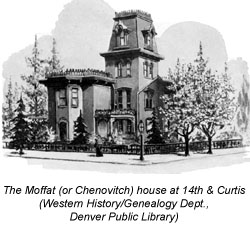Telecommunications History Group Resources
931 14th St. Historic Building
The Growth of Denver - Building Site History
 After the Fort Wise Treaty of 1861 moved the Arapaho Indians out of the area, settlers were free to build as they wished in what was to become—much, much later—the Denver metropolitan area. The discovery of gold a few years earlier led to mass migrations of tens of thousands of would-be settlers looking to get rich. Most of them left the area after finding nothing or longing for more civilized surroundings, resulting in a “city” of 35,000 inhabitants during the 1860s.
After the Fort Wise Treaty of 1861 moved the Arapaho Indians out of the area, settlers were free to build as they wished in what was to become—much, much later—the Denver metropolitan area. The discovery of gold a few years earlier led to mass migrations of tens of thousands of would-be settlers looking to get rich. Most of them left the area after finding nothing or longing for more civilized surroundings, resulting in a “city” of 35,000 inhabitants during the 1860s.
The gold rush allowed Denver to grow quickly, and it established itself as the miners’ home base, where they could return from forays into the nearby mountains to buy supplies, rest, and gamble away anything valuable they’d found. By 1865 Denver was named the capital city of the Colorado Territory, and by 1890 it was the second most populous city in the West (San Francisco being first) with over 100,000 inhabitants.
The boom came to an abrupt end, however, in 1893, when a depression and a drop in the price of silver had the potential to turn Denver into just another failed mining town. Fortunately, the city had already begun to diversify. It continued to grow as an agricultural processing center, a haven for people seeking cures for respiratory illness, a manufacturing hub, and a base for tourism.
Lifestyles of the Rich
Denver’s boom time drew a host of mining magnates and adventurous investors, financiers, and industrialists. These wealthy patrons of society wanted to bring culture to the high plains, and they did so by building schools, cultural centers, and, of course, mansions. The area around 14th and Curtis became a focal point for society’s elite.
The house at 14th and Curtis, the site on which, a few decades later, the telephone building would be built, may have belonged to David Moffat (according to The Mountain States Monitor), an entrepreneur involved in bringing the railroad to Colorado. According to images of the house in the Western History Dept. of the Denver Public Library, however, the house belonged to Vasso L. Chenovitch, about whom little is known. Regardless, this was a very respectable part of town. How did the telephone company snap up such a swanky address? And how did it manage to build a telephone building in the heart of elite society? Well, it didn’t, exactly.
The years between the 1880s and the mid-1920s were not kind to the 14th and Curtis area. And it became a sort of skid row.
Growth of Denver Resources:
- Denver: Mining Camp to Metropolis by Stephen J. Leonard & Thomas J. Noel (1990)
- Tom Noel’s history of Denver on the Denver city government
- Western History / Genealogy Department Denver Public Library
- Colorado Historical Society and www.city-data.com/us-cities/The-West/Denver-History.html
